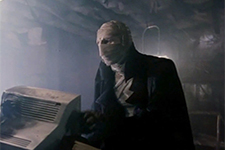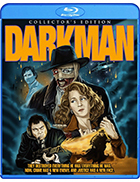Darkman
|  It’s hard to believe now, but there was a time when movies based on or inspired by comic books were not only not the dominant trend at the box office, but were relatively rare. Part of this had to do with technology, or lack thereof; prior to the widespread adoption in the mid-1990s of computer-generated imagery as the go-to means of producing otherwise impossible images, a filmmaker’s ability to translate drawings from a comic book, which are free to thwart, side-step, or simply obliterate the laws of physics and any other restraints of the physical world, to the big screen were limited. Richard Donner’s Superman (1978) had promised the world that “You’ll believe a man can fly,” and while that film and its simultaneously shot 1980 sequel were major hits, it would be nearly a decade before Tim Burton’s Batman (1989) once again made a serious bid to close the gap between page and screen. The year after Burton’s Batman saw the release of Sam Raimi’s Darkman, which, while not directly adapted from any particular source, is clearly grounded in the narrative, visual, and tonal logic of comic books. Raimi had gained cult fame with his goofy-gory The Evil Dead (1982) and Evil Dead II (1987), both of which bore more than a few traces of the outlandish possibilities of comic book movies. Produced and distributed by Universal Pictures, Darkman was Raimi’s first stab at a major studio-produced feature (not counting his 1985 Coen Brother collaboration Crimewave, a compromised box-office flop, which was an independent production distributed by Columbia Pictures), and you can feel in every scene that he is pushing at the limits, straining to expand the possibilities, and going for broke at every possible turn. A mash-up of classic Universal monster movies, gangster flicks, action thrillers, and science fiction, it is a fascinating bridge between Raimi’s indie gonzo-horror movies and his later prominence as the blockbuster director of the Spider-Man trilogy (2002–2006) and Disney’s Oz the Great and Powerful (2013). The film’s protagonist, Dr. Peyton Westlake (aka He Who Will Become Darkman), is played by a then relatively unknown Liam Neeson, whose lead role in Steven Spielberg’s Schindler’s List (1993) three years later would establish him as a major force. Peyton is an amiable scientist who is working doggedly on a technique for growing synthetic skin. His girlfriend, Julie Hastings (Frances McDormand), is a crusading journalist whose nose for news gets Peyton caught in the crosshairs of Louis Strack Jr. (Colin Friels), a malicious corporate real estate tycoon who makes use of a small army of sneering mercenaries led by the sadistic Robert Durant (Larry Drake). Durant and company burn Peyton’s lab to the ground, in the process terribly mutilating his face and hands, and everyone, including Julie, assumes Peyton is dead. Meanwhile, he essentially resurrects himself and goes back to his business of trying to grow synthetic skin in an abandoned warehouse-turned-laboratory, but he keeps running into the same problem: Whatever skin he grows lasts only 99 minutes before melting into mush. Thus, he is able to reconstruct his own face, but only temporarily; in a little over an hour and half, it will start melting away, revealing the horrifying skull-like visage beneath. The film’s second half deals primarily with Peyton’s attempt to rebuild his relationship with Julie while keeping secret his disfigurement and seeking vengeance against Strack and Durant, who represent all that is soulless and corrupt. Peyton himself is emotionally and morally compromised due to a medical procedure that eliminated the pain from his burns, but also results in anger and aggression, which come out in a particularly vexed and comedic moment at a fair when a carny tries to cheat him out of a stuffed elephant. Wrapped in dirty bandages and hunched down in a floor-length black trench-coat and fedora, Peyton is part-Mummy, part-Phantom of the Opera, and part The Shadow, with a good dose of Ivor Novello ’s titular character from Hitchcock’s The Lodger (1927) thrown in for good measure. Peyton’s charming, likable scientist-to-disfigured avenger narrative arc is also curiously similar to Wes Craven’s Swamp Thing (1982), which was one of the few genuine comic book adaptations of the previous decade. However, as much as it resembles other films, Darkman is uniquely Raimi through and through (the film’s energy is immediately recognizable as the work of the mind behind the Evil Dead franchise). Raimi’s collaborator behind the camera was cinematographer Bill Pope, who at the time had shot only one other feature (1989’s Death Doll), but = would go on to shoot the highly influential The Matrix trilogy (1999–2003), Raimi’s three Spider-Man films, and several of Edgar Wright’s films, including, most recently, Baby Driver (2017). They move the camera with unfettered glee as a means of evoking the wild abandon of the comic book page, which makes for a natural fit with Raimi’s penchant for rapid shifts in perspective, sudden movements, and extreme close-ups. The look of Darkman would have been immediately familiar to his cult fans, even if it never quite matches the levels of campy chaos he unleashed in his earlier films. There is an undeniable cheese factor at times, but it’s intentional, purposeful, and about as finely wrought as cheese can be. Raimi knows he’s working on the fringes, straddling the line between studio bankability and an independent’s desire to throw caution to the wind and stick it to the system, and while Darkman doesn’t consistently find the sweet spot between those extremes, it is still a fun diversion that reminds us of how enjoyably loony the movies can be.
Copyright © 2017 James Kendrick Thoughts? E-mail James Kendrick All images copyright © Shout! Factory / Universal Pictures | |||||||||||||||||||||||||||||||
Overall Rating: 

 (3)
(3)


